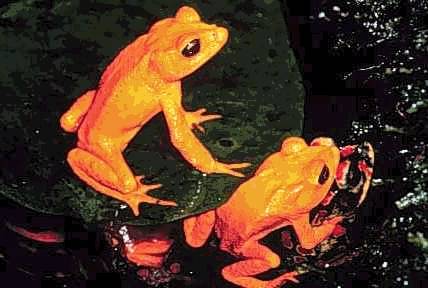
Global Warming has killed off its first species
An exploration by Christi Geisinger
Toads are not naturally appealing to a large amount of people. Why should we be concerned about the desertion of one geographically limited amphibian, like the Monteverde Golden Toad? This tiny tropical toad is more enchanting and puzzling than it seems an amphibian could be. Its glamour is nature-made but its mysterious decline is most likely due to humans. Golden toads have never been well known, but they used to be plentiful in a handful of areas of cloud-shrouded tropical forest above the Costa Rican town called Monteverde. No one has spotted these little golden toads since 1989. Rainforests in Monteverde, Costa Rica were their home where there diet consisted of insects mainly. Humans, acid rain, and slash and burn were their enemies.

The males are just about two inches long and extraordinarily bright orange. Unlike most toads, their skin is shiny and radiant. They appeared as if they had been dipped in enamel paint. The females look different, but just as spectacular. Slightly larger than the males, females are dark olive to black with spots of scarlet encircled by yellow. Their unfathomable dark eyes stood out on the bright orange males, and females ranging from light yellow to dark olive: the golden toad (Bufo periglens) stands as a symbol for environmental protection.
Very little is known about golden toad activities. In the Monteverde forest, golden toads were famous only during the reproduction season. For a few weeks each April, the males gathered in groups of hundreds in little pools of water to linger for females. Breeding activities lasted a week or two, and then the toads would disappear for another year. The eggs were laid in seasonal water catchments, where the tadpoles would hatch and grow into adults in a very short time.
In 1987, the golden toad was closely studied and was described as "little jewels on the forest floor." One researcher was so fascinated that she applied for a grant to return and study the toads. In 1988, no toads appeared when the seasonal rains started. During several months of searching the Monteverde forest, scientists found a total of ten golden toads, and none were breeding. In 1989, only one lonely toad was found where once there were hundreds. Despite much searching, not a single golden toad has been seen since then.
Amphibians in general are particularly sensitive to changes in their habitat and in climate because they live both on land and in water, they are both predators and prey, and they have permeable skin. Many factors appear to be interacting to cause their decline. Habitat destruction and alteration has taken its toll on amphibians. Worldwide, ponds, rivers, and marshes have been drained, diverted, and polluted; recreational lakes are stocked with non-native fish or frogs that out-compete or prey on native species; forests are logged or converted to cropland or pasture; and human development obliterates other amphibian habitats. Habitat destruction does not explain the disappearance of the Monteverde golden toad, however. The high-elevation rain forest where it lived is a relatively pristine area, protected as a national reserve since the 1970s. The Golden toad’s sudden disappearance from the cloud forest of Monteverde may also symbolize a warning of what could happen to the world if severe deforestation continues.

The Golden Toad is well on their way to extinction and none have been seen since 1989. The Monteverde Golden Toad may live up to 12 years. No golden toads have been seen in the last twelve years. Is it too early to say they are extinct? For an animal to be pronounced extinct, there must be no sightings in the last 50 years. The golden toad of Costa Rica may have been driven to extinction by climate change, scientists believe. The toad's demise has been revealed by research into the changing populations of species in Costa Rica. The scientists have concluded that rising temperatures may have been to blame. The disappearance of the toad is part of a pattern of change that is affecting not only amphibians but also reptiles and birds as well.
 Leap to these sites to check out the articles:
Leap to these sites to check out the articles:
Submitted to and posted by Anthony Benoit
May 15, 2001
Top | Back | Explorations | ENV 1100